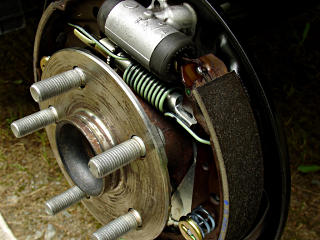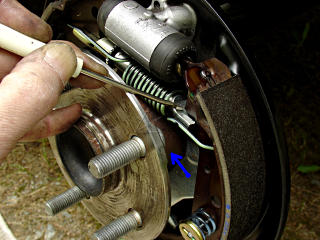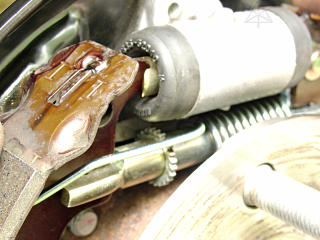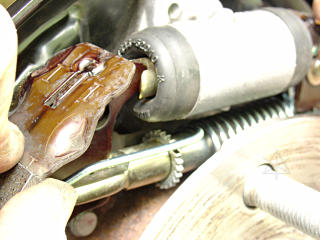Rear brake self-adjuster mechanism (Prius)
Shortly after the "brake job" page was created, the question came up of
exactly how, or more properly when, the rear drum brakes in the Prius self-
adjust. Almost all drum brakes have been able to self-adjust for years, but
many of them required something special to happen, such as applying the
parking brake while rolling backwards, or some subset thereof. The theory
was floated in the forums that in the case of the Prius, simply using the
parking brake on occasion was sufficient to advance the auto-adjusting
screw mechanism and reset the "rest" position of the brake shoes a little
farther out, compensating for wear. But nobody was really sure.
Of course, I *had* to know.
I had just had these things apart last week, and the day was looking like a
serious threat of rain, but out I went with lug wrench and camera in hand,
pulled the two relays, and removed the same left rear wheel featured in the
main page. Then, kept going and disassembled the rest of the brake
mechanicals. Well, there just isn't that much to it, but what's in there is
quite clever.
Use any of the big-picture links for a clearer look.
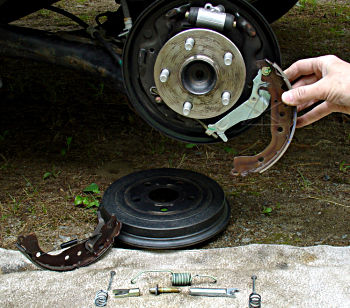
One thing to note here is that the parking brake lever is pivoted to the top
of the rear shoe. A little farther down, it passes next to a notch that the
adjuster sits in, so it too can push on another part of the adjuster fork.
The parking brake cable arrives at the bottom, giving a mechanical-advantage
lever arm between the cable and the adjuster fork.
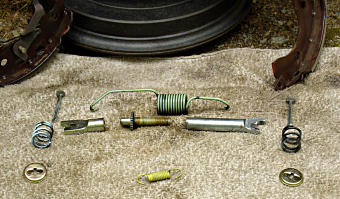
The small parts, with the adjuster exploded open. There's a healthy amount
of grease on its threads and the rotating pin at the other end. That big green
spring is a pain in the ass to remove, but once it and the shoe retainer pins
are out, the rest all just falls apart.
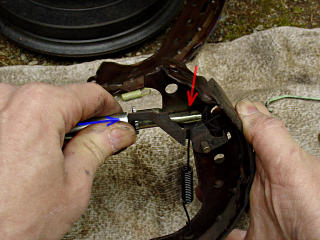
|
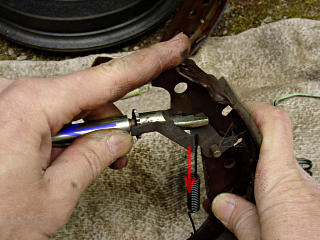
|
|
Adjuster pushed
|
Adjuster relaxed
|
On the backside of the leading shoe is a little lever, which pivots on the
shoe frame and has a spring pulling it down fairly hard. When the adjuster
screw mechanism is in place, part of its fork bears on another part of the
lever [first picture, red arrow] and cocks the lever's little finger upward
when the adjuster is held firmly against the shoe. Which it is when the whole
brake is relaxed -- the adjuster's length defines how far inward the shoes can
relax. When the shoe moves far enough outward due to some force other than the
adjuster bearing on it [i.e. when the hydraulic piston pushes on it instead],
the lever is free to move downward pulled by the spring [second picture, red
arrow]. What does the finger do? Since it is also slapped up against the
cogwheel on the adjustment screw, it grabs a tooth and pulls it down a notch
or two. When the shoe sits back against the adjuster, the lever finger gets
cocked back up again for another pass. The teeth on the adjuster wheel are
angled to catch the finger and assist the working of this motion.
If the shoe doesn't move outward far enough, the lever doesn't drop far
enough to advance a tooth. That's what happens when the shoes are in proper
adjustment, in fact -- held *just* away from the drum, but not so far away
that they undergo any significant travel.
What does this imply? That the self-adjustment is NOT done via the parking
brake in this case. The parking brake lever works *through* the adjuster
rod, using it to wedge the shoes apart, and thus does not let the adjuster
relax off the shoe frame. It's when the *pistons* actuate the brakes, such
as during normal stops while driving, that the brakes will adjust if needed.
No rolling-backwards or parking-brake games required at all. So my initial
quick observation, "gee, I pulled the shoes apart and the adjuster clicked
forward", was correct, but not during parking brake usage.
This seems contrary to what many of us may be familiar with, but the following
pictures may help clarify what's going on in there a little. One reason this
configuration is different is that many older parking-brake systems use a lever
and cam to spread the *lower* ends of the shoes, using the piston end as a
pivot, so a self-adjust mechanism for that would have to be quite different.
In these brakes, the lower pivot is simply a pivot, and never moves. Simple,
elegant, and largely worry-free, like so many other things we love about
this car.
The screwdriver [second picture] points to a gap created when the parking brake
lever acts on the adjuster fork [behind the shoe frame], forcing it away from
the shoe. This pushes the tops of the shoes apart. But since that force goes
to the other shoe via the adjuster, the spring lever on it has no chance to
drop down.
But when something else pushes the shoes apart, different things happen.
Here we're simulating a hydraulic piston push [which would be bad to actually
try, because if unrestrained the pressure could pop the pistons right out
of the cylinder and wreck the seals and spew fluid all over] by simply pulling
the shoes apart. Note the spring-lever finger, back in its dark, blurry hole.
Now that the pressure on the adjuster is momentarily relieved, the spring lever
is free to whack the adjuster down a tooth, which unscrews the pin just a
little. On return, the finger skips over a tooth [maybe more?] to a new
position.
The pistons aren't under any pressure here. In this case they tend to try and
slowly follow along with movement anyways, possibly due to a little residual
pressure in the line [simply from gravity?], so their motion that happens
during normal braking is more or less represented. The ideal demo would be a
drum with most of the center portion cut out, leaving a ring to limit the shoe
motion and just enough to mount on the hub, through which one could shoot live
*video* of all this with the brake system in full operation. But we make do.
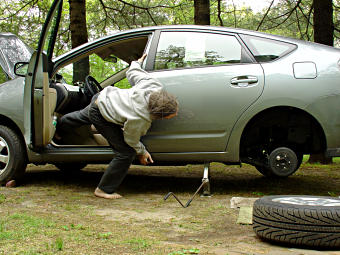
And here's the final proof. I put the brake back together, cleaning and
greasing various mating surfaces along the way because rust really is the
bane of these things, and slapped the drum on with one lugnut to hold it.
The adjuster rod was several turns in from where it should have been, i.e.
the brake was now misadjusted with too much free play. With the hydraulics
once again constrained, I could reinstall the relays and let the system
pressurize. Then, I got into "official test position" shown above, and
slowly pushed various pedals and just *listened* carefully to the brake.
Several slow pushes of the emergency/parking brake: other than a couple of
soft creaks from things re-seating, no noise.
A slow push of the main brake pedal, allowing the accumulator to run some
more and bring the system up to full pressure: nothing yet...
Let off main brake: CLICK! I could definitely hear the adjuster advance.
Slow push and release of parking brake: nothing
Slow push and release of main brake: click!
So I kept using the main brake and throwing in occasional pushes of the parking
brake, just to make sure everything was seating right, until the adjuster
clicking finally stopped. At this point, the parking brake felt much tighter
than when I started, and upon removing the drum again I could see that the
adjuster was unscrewed farther out.
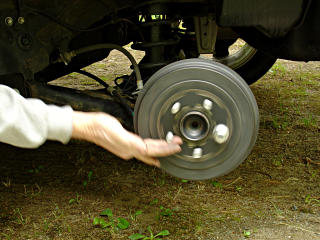
And even after all that, the hub spins freely without ANY dragging when the
brakes are let off. So there shouldn't be any need to go in and fool with
backing off the brake shoes in advance of an MPG competition, for instance,
because when the brakes have settled themselves into proper adjustment they
pull 100% clear of the drum as they should. Keeping the parts inside clean
and well-lubricated allows them to do this job properly, so getting that done
is really the proper continuation of the "spring maintenance" brake work.
Keeping Prius brake mechanisms clean, or brakes in any hybrid for that matter,
is made much easier by how little they get used! It's hard to look at any
conventional car nowadays without noticing all the brake dust sprinkled around
the hubs, particularly the fronts, and wondering how many sets of pads the
owner's already worn through.
_H* 070517






